端杂七杂八系列篇四-Java8篇
发布时间:2024年01月19日
后端杂七杂八系列篇四-Java8篇
① Lombok插件
Lombok是一个可以通过简单的注解的形式来帮助我们简化消除一些必须有但显得很臃肿的 Java 代码的工具。
① @RequiredArgsConstructor
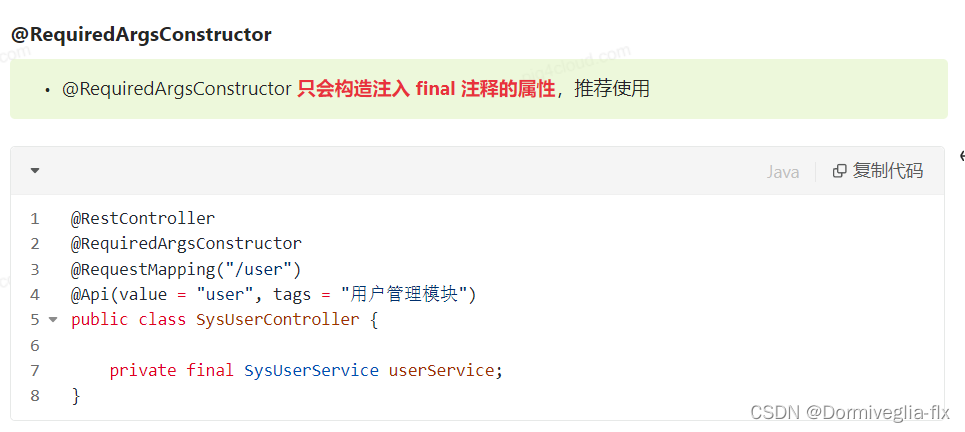
② @SneakyThrows
在 Java 中,异常被分为了
受查异常(checked exception)和非受查异常(unchecked exception)两种。
非受查异常又叫运行时异常,即 RuntimeException。
受查异常,即 Exception。
受查异常是Java给你检查的异常,需要你手动try catch
比如这个,写的时候会报错,IDE会提示我们需要加上try catch
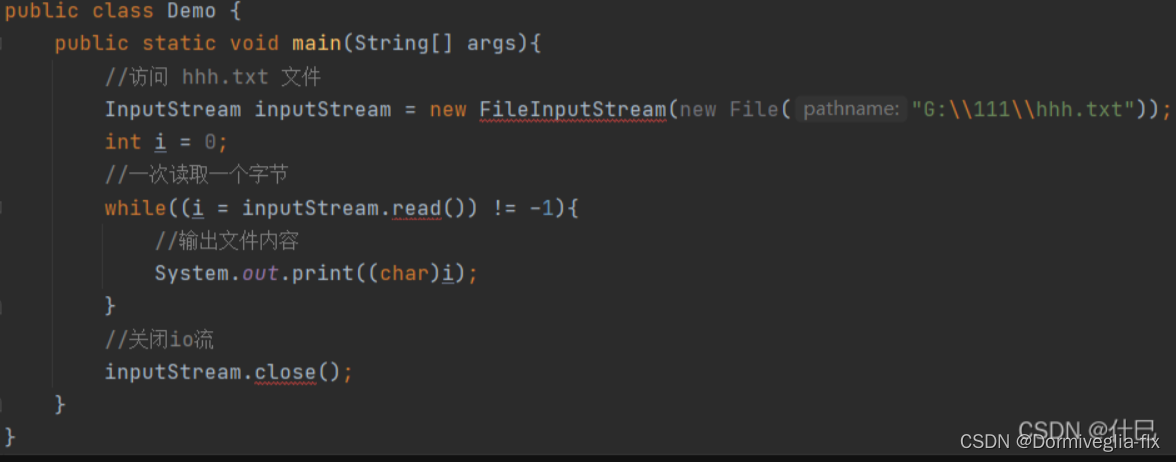
运行时异常是Java 运行时候报出来的异常,一般是我们程序员写错了。
我们的@SneakyThrows就是为了让我们少写try catch 代码, 即在有受查异常的时候,我们加上注解,就不用写try catch了。
代码举例
import lombok.SneakyThrows;
public class SneakyThrowsDemo {
// 使用注解
@SneakyThrows
public String readFile(String filePath) {
File file = new File(filePath);
BufferedReader reader = new BufferedReader(new FileReader(file));
StringBuilder content = new StringBuilder();
String line;
while ((line = reader.readLine()) != null) {
content.append(line).append("\n");
}
reader.close();
return content.toString();
}
// 不使用注解
public String readFileWithout(String filePath) {
try{
File file = new File(filePath);
BufferedReader reader = new BufferedReader(new FileReader(file));
StringBuilder content = new StringBuilder();
String line;
while ((line = reader.readLine()) != null) {
content.append(line).append("\n");
}
reader.close();
return content.toString();
}catch(e){
}
}
public static void main(String[] args) {
SneakyThrowsDemo demo = new SneakyThrowsDemo();
// 无需捕获FileNotFoundException和IOException
System.out.println(demo.readFile("example.txt"));
}
}
③ @UtilityClass
用于定义工具类的时候,不用定义static的方法了。
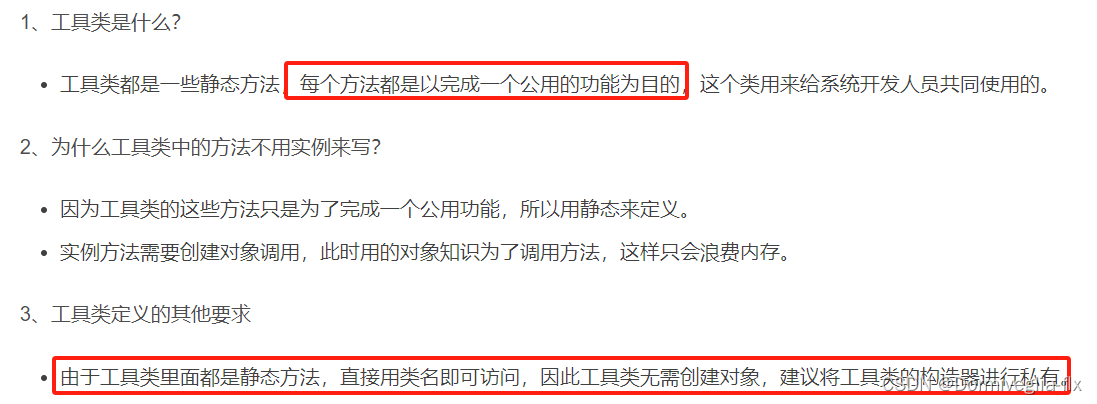
举个例子
public class UtilClass {
// 静态变量,全局存储
public static int globalCount = 0;
// 静态方法,可以直接通过类名调用,无需创建对象
public static void incrementCount() {
globalCount++;
}
// 其他静态工具方法
public static String formatString(String input) {
return "Formatted: " + input.toUpperCase();
}
// 使用示例:
public static void main(String[] args) {
// 不需要创建UtilClass对象,直接访问静态成员
UtilClass.incrementCount();
System.out.println(UtilClass.globalCount); // 输出:1
String formattedString = UtilClass.formatString("hello world");
System.out.println(formattedString); // 输出:Formatted: HELLO WORLD
}
}
在Java中,静态工具类中的属性默认情况下是可以一直保留的,除非显式地进行修改或者JVM垃圾回收机制清除了该类的Class对象(这在正常应用中非常罕见)。
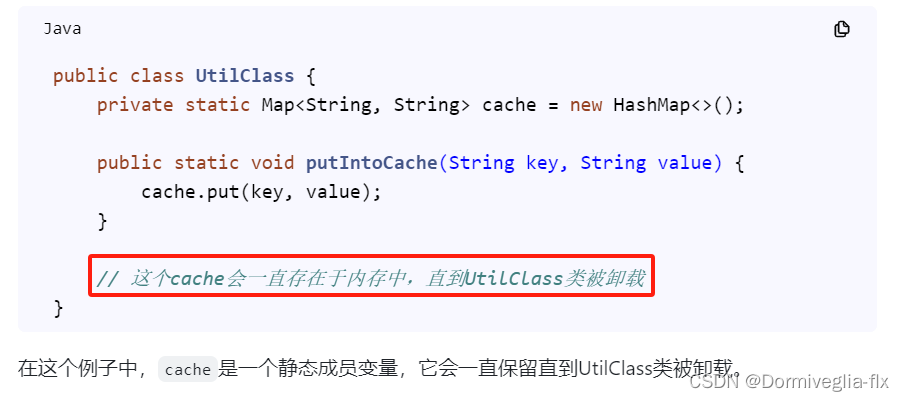

使用注解时候的demo
@UtilityClass
public class WxMpContextHolder {
private final ThreadLocal<String> THREAD_LOCAL_APPID = new TransmittableThreadLocal<>();
/**
* TTL 设置appId
* @param appId
*/
public void setAppId(String appId) {
THREAD_LOCAL_APPID.set(appId);
}
/**
* 获取TTL中的appId
* @return
*/
public String getAppId() {
return THREAD_LOCAL_APPID.get();
}
public void clear() {
THREAD_LOCAL_APPID.remove();
}
}
④ @Cleanup
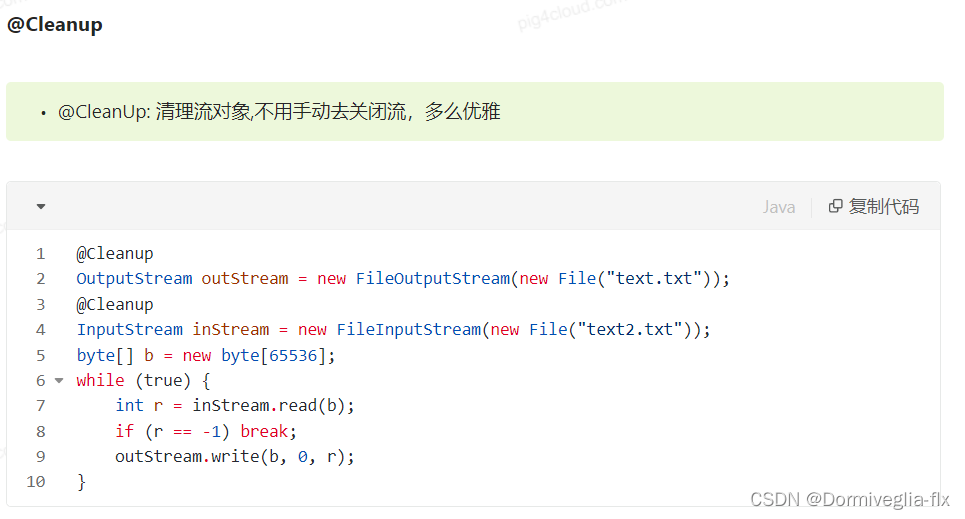
// Java 标准的写法
public class CleanupExample {
public static void main(String[] args) throws IOException {
InputStream in = new FileInputStream(args[0]);
try {
OutputStream out = new FileOutputStream(args[1]);
try {
byte[] b = new byte[10000];
while (true) {
int r = in.read(b);
if (r == -1) break;
out.write(b, 0, r);
}
} finally {
if (out != null) {
out.close();
}
}
} finally {
if (in != null) {
in.close();
}
}
}
}
// 注解的写法
public class CleanupExample {
public static void main(String[] args) throws IOException {
@Cleanup InputStream in = new FileInputStream(args[0]);
@Cleanup OutputStream out = new FileOutputStream(args[1]);
byte[] b = new byte[10000];
while (true) {
int r = in.read(b);
if (r == -1) break;
out.write(b, 0, r);
}
}
}
② Lambda 4个常用的内置函数
① Function<T, R> - 接受一个输入参数并返回一个结果
public class FunctionDemo {
public static void main(String[] args) {
List<String> names = Arrays.asList("Alice", "Bob", "Charlie");
// 使用lambda表达式转换字符串为大写
Function<String, String> toUpperCase = s -> s.toUpperCase();
names.stream()
.map(toUpperCase)
.forEach(System.out::println);
}
}
② Consumer - 接受一个输入参数,并执行某种操作(无返回值)
public class ConsumerDemo {
public static void main(String[] args) {
List<Integer> numbers = Arrays.asList(1, 2, 3, 4, 5);
// 使用lambda表达式打印数字
Consumer<Integer> printNumber = n -> System.out.println("Number: " + n);
numbers.forEach(printNumber);
}
}
③ Supplier - 不接受任何参数,但产生一个结果
public class SupplierDemo {
public static void main(String[] args) {
// 使用lambda表达式生成随机数
Supplier<Integer> randomIntSupplier = () -> (int) (Math.random() * 100);
System.out.println("Random number: " + randomIntSupplier.get());
}
}
④ Predicate - 接受一个输入参数并返回一个布尔值
public class PredicateDemo {
public static void main(String[] args) {
List<String> fruits = Arrays.asList("Apple", "Banana", "Cherry", "Durian");
// 使用lambda表达式检查字符串长度是否大于5个字符
Predicate<String> isLongFruit = fruit -> fruit.length() > 5;
fruits.stream()
.filter(isLongFruit)
.forEach(System.out::println);
}
}
③ Optional




用法例子一
public class Student {
private String name;
private int age;
private Integer score;
//省略 construct get set
}
public List<Student> initData(){
Student s1 = new Student("张三", 19, 80);
Student s2 = new Student("李四", 19, 50);
Student s3 = new Student("王五", 23, null);
Student s4 = new Student("赵六", 16, 90);
Student s5 = new Student("钱七", 18, 99);
Student s6 = new Student("孙八", 20, 40);
Student s7 = new Student("吴九", 21, 88);
return Arrays.asList(s1, s2, s3, s4, s5, s6, s7);
}
@Test
public void beforeJava8() {
List<Student> studentList = initData();
for (Student student : studentList) {
if (student != null) {
if (student.getAge() >= 18) {
Integer score = student.getScore();
if (score != null && score > 80) {
System.out.println("入选:" + student.getName());
}
}
}
}
}
@Test
public void useJava8() {
List<Student> studentList = initData();
for (Student student : studentList) {
Optional<Student> studentOptional = Optional.of(student);
Integer score = studentOptional.filter(s -> s.getAge() >= 18).map(Student::getScore).orElse(0);
if (score > 80) {
System.out.println("入选:" + student.getName());
}
}
}
用法例子二
public String test0(AlarmAllParmeter alarmAllParmeter) {
String errorResult = "";
if (null != alarmAllParmeter) {
Integer alarmId = alarmAllParmeter.getAlarmEventInputId();
if (null != alarmId) {
AlarmEventInput alarmEventInput = alarmEventInputService.get(alarmId);
if (null != alarmEventInput) {
String alarmName = alarmEventInput.getAlarmName();
int alarmType = alarmEventInput.getAlarmType();
return String.valueOf(alarmType) + "-" + alarmName;
} else {
return errorResult;
}
} else {
return errorResult;
}
} else {
return errorResult;
}
}
// 改进方案一
public String test1(AlarmAllParmeter alarmAllParmeter){
String errorResult = "";
Optional<AlarmAllParmeter> op = Optional.ofNullable(alarmAllParmeter);
if(op.isPresent()){
Integer alarmId = op.get().getAlarmEventInputId();
Optional<Integer> op1 = Optional.ofNullable(alarmId);
if(op1.isPresent()){
AlarmEventInput alarmEventInput = alarmEventInputService.get(op1.get());
Optional<AlarmEventInput> op2 = Optional.ofNullable(alarmEventInput);
if (op2.isPresent()) {
String alarmName = alarmEventInput.getAlarmName();
int alarmType = alarmEventInput.getAlarmType();
return String.valueOf(alarmType) + "-" + alarmName;
} else {
return errorResult;
}
}
else {
return errorResult;
}
}
else {
return errorResult;
}
}
// 改进方案二
public String test2(AlarmAllParmeter alarmAllParmeter){
return Optional.ofNullable(alarmAllParmeter)
.map(a -> a.getAlarmEventInputId())
.map(a -> alarmEventInputService.get(a))
.map(a -> String.valueOf(a.getAlarmType())+"-"+a.getAlarmName())
.orElse("");
}
④ 常用Stream流
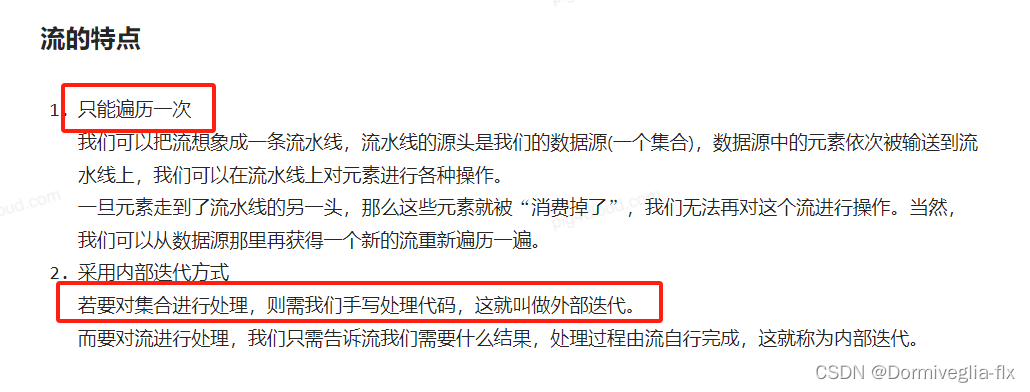
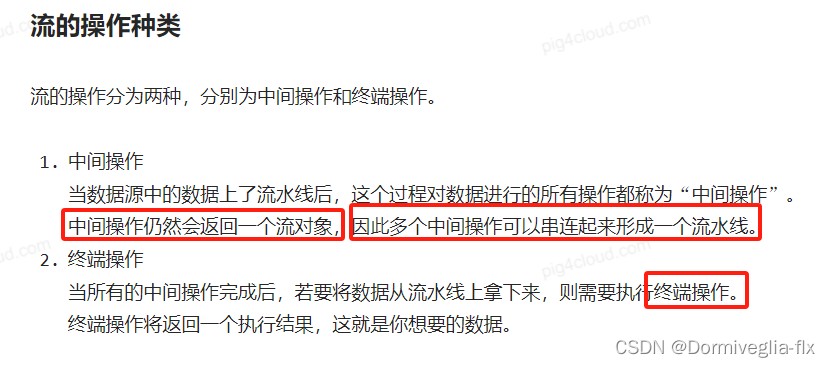
stream 中间操作
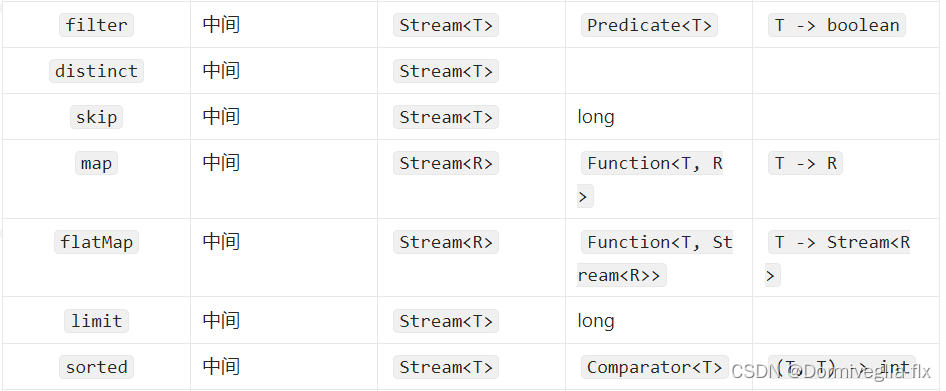
// filter
List<Person> result = list.stream()
.filter(Person::isStudent)
.collect(toList());
// distinct
List<Person> result = list.stream()
.distinct()
.collect(toList());
// limit
List<Person> result = list.stream()
.limit(3)
.collect(toList());
// skip
List<Person> result = list.stream()
.skip(3)
.collect(toList());
// map
List<String> result = list.stream()
.map(Person::getName)
.collect(toList());
stream 终端操作

// anyMatch
boolean result = list.stream()
.anyMatch(Person::isStudent);
// allMatch
boolean result = list.stream()
.allMatch(Person::isStudent);
// noneMatch
boolean result = list.stream()
.noneMatch(Person::isStudent);
// findAny
Optional<Person> person = list.stream().findAny();
// findFirst
Optional<Person> person = list.stream().findFirst();
Java 8中的Future和CompletableFuture

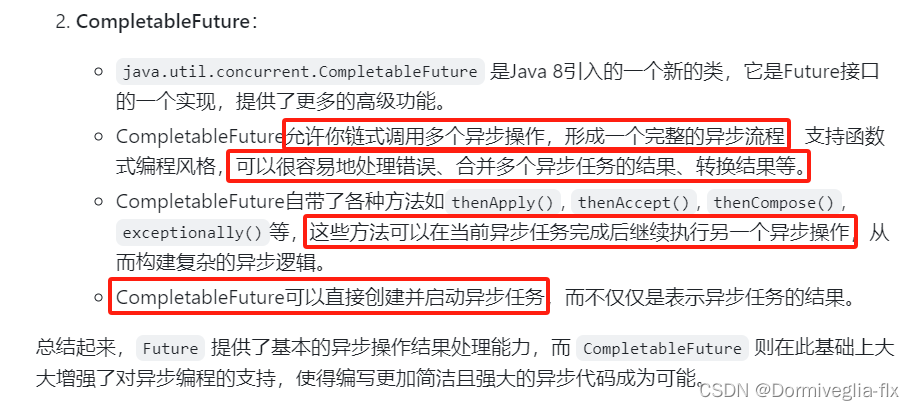
Future
用法demo
public class FutureExample {
public static void main(String[] args) throws ExecutionException, InterruptedException {
// 创建一个线程池
ExecutorService executor = Executors.newSingleThreadExecutor();
// 提交一个Callable任务到线程池,返回一个Future对象
Future<String> future = executor.submit(new Callable<String>() {
@Override
public String call() throws Exception {
Thread.sleep(2000); // 模拟耗时操作
return "Hello from Future!";
}
});
// 主线程可以继续执行其他任务,不被阻塞
System.out.println("Main thread is doing other tasks...");
// 当需要获取结果时,调用Future的get方法,该方法会阻塞直到结果准备好
String result = future.get();
System.out.println(result);
// 关闭线程池
executor.shutdown();
}
}
CompletableFuture
用法demo
public class CompletableFutureExample {
public static void main(String[] args) throws ExecutionException, InterruptedException {
// 创建一个CompletableFuture对象并提供一个异步计算的任务
CompletableFuture<String> future = CompletableFuture.supplyAsync(() -> {
try {
Thread.sleep(2000); // 模拟耗时操作
} catch (InterruptedException e) {
Thread.currentThread().interrupt();
}
return "Hello from CompletableFuture!";
});
// 使用thenApply方法进行链式处理,将上一步的结果转换为新的结果
CompletableFuture<Integer> lengthFuture = future.thenApply(result -> result.length());
// 使用thenAccept方法处理完成后的结果,不返回任何值
lengthFuture.thenAccept(length -> System.out.println("Length: " + length));
// 等待所有任务完成
CompletableFuture.allOf(future, lengthFuture).join();
// 或者直接获取结果(这会阻塞直到结果准备好)
// int length = lengthFuture.get();
// System.out.println("Length: " + length);
}
}
文章来源:https://blog.csdn.net/sugerfle/article/details/135700795
本文来自互联网用户投稿,该文观点仅代表作者本人,不代表本站立场。本站仅提供信息存储空间服务,不拥有所有权,不承担相关法律责任。 如若内容造成侵权/违法违规/事实不符,请联系我的编程经验分享网邮箱:chenni525@qq.com进行投诉反馈,一经查实,立即删除!
本文来自互联网用户投稿,该文观点仅代表作者本人,不代表本站立场。本站仅提供信息存储空间服务,不拥有所有权,不承担相关法律责任。 如若内容造成侵权/违法违规/事实不符,请联系我的编程经验分享网邮箱:chenni525@qq.com进行投诉反馈,一经查实,立即删除!
最新文章
- Python教程
- 深入理解 MySQL 中的 HAVING 关键字和聚合函数
- Qt之QChar编码(1)
- MyBatis入门基础篇
- 用Python脚本实现FFmpeg批量转换
- 【Linux】Shell 命令以及运行原理
- 【STM32F103】RCC复位和时钟控制
- 基于SSM的图书商城(有报告)。Javaee项目。ssm项目。
- [Redis实战]分布式锁-redission
- 方块转换 Transformations(洛谷)(浇浇我)
- Java电影购票小程序在线选座订票电影
- Clojure 实战(4):编写 Hadoop MapReduce 脚本
- 海康威视运行管理中心 Fastjson RCE
- 使用Java构建机器人应用
- Java实现CR-图片文字识别功能(超简单)